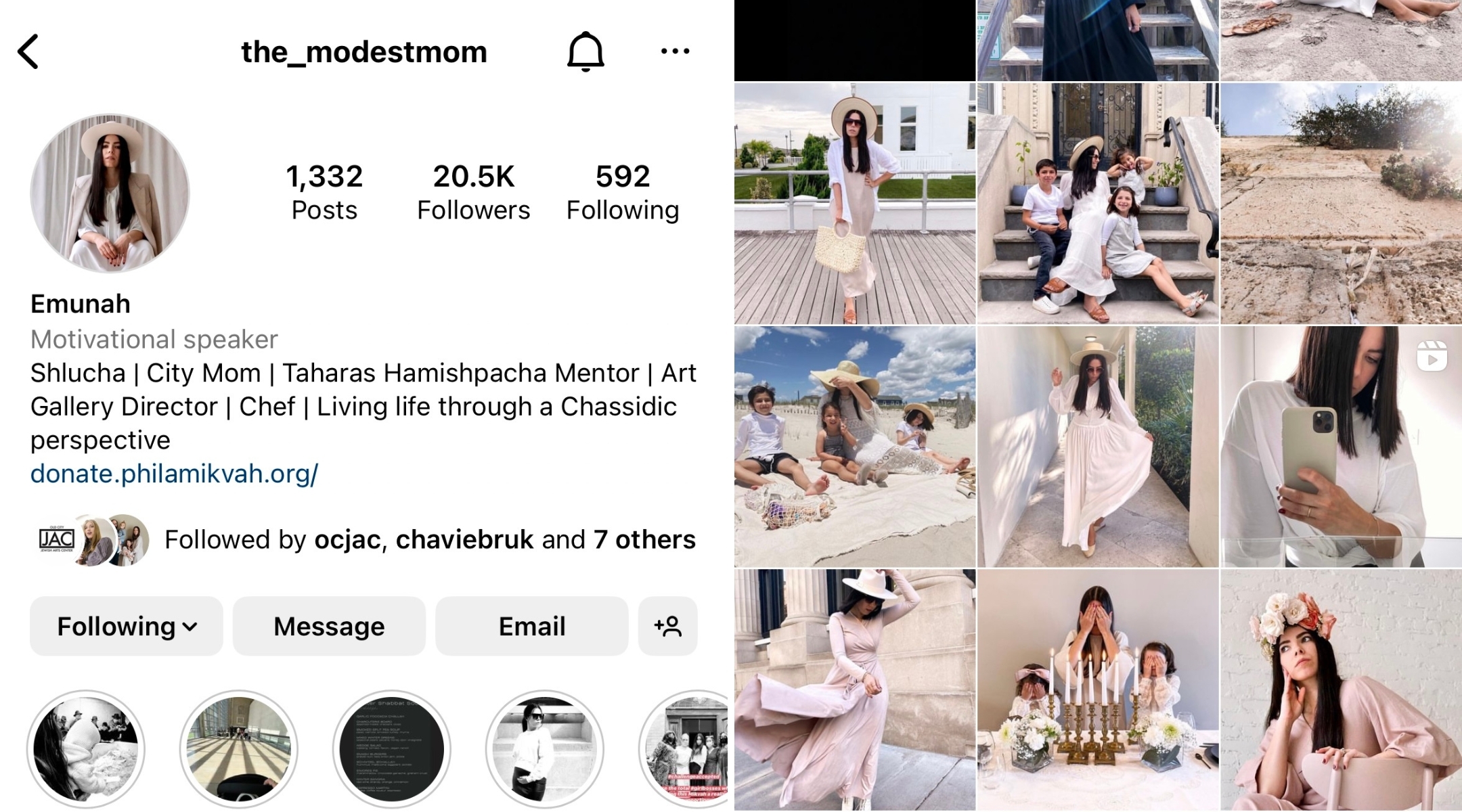Chabad women come together once a year in person. The rest of the time, there’s Instagram.

In a Throwback Thursday post from the Chabad Zambia Instagram account, Rivky Hertzel shared how she turned toilet plungers into DIY rolling pins for a mock matzah bake. (Screenshots via Instagram. Design by Jackie Hajdenberg)
(JTA) — The first post on Rivky Hertzel’s Instagram account — which she and her husband signed up for last year ahead of a planned move to Zambia — depicts a classic Chabad activity: a mock matzah bake for children that the couple organized in Lusaka, the country’s capital, ahead of last Passover.
But like many Instagram posts, the cheerful photo didn’t exactly tell the whole story:
The kids’ chef hats were made out of paper, their aprons were made out of garbage bags, and their rolling pins were actually the detached handles of toilet plungers — wrapped in Saran Wrap — that Hertzel picked up on the fly at a local store when she realized she was short on baking supplies.
Only after the bake was done did Hertzel, 22, reveal the origins of the “rolling pins.” Much to her relief, the kids’ parents had a good laugh about it.
And months later, in a “Throwback Thursday” post, Hertzel shared a photo of the deconstructed toilet plungers themselves. The red ends of the plungers sat in rows next to the separated handles.
“What do you think we used the plungers for?” she wrote. One viewer responded, “Moshe’s staff.” Another wrote, “As a plunger:).” She then revealed that they were rolling pins, to her followers’ delight.
“I have friends in Alaska and in New York and anywhere else, and I think they were excited and kind of inspired by that,” Hertzel told the Jewish Telegraphic Agency. “When you’re living in New York, what are you thinking about Jewish kids in Africa? No one’s thinking about it. They were inspired by the lengths that we were willing to go to make a special Jewish experience for kids.”
Hertzel’s experience is an example of the increasingly significant and versatile role Instagram is playing in the lives of Chabad’s women emissaries, known as shluchos. Nearly 4,000 shluchos gathered this past weekend for a conference that concluded with a massive gala dinner at a New Jersey convention center. But during the rest of the year, many of the emissaries live without a robust local Orthodox support system, often taking the lead in organizing Jewish activities in far-flung locales with few, if any, other observant Jews.
To fill that gap, some have turned to Instagram as a vehicle to document both their work and personal lives. And as a younger generation of emissaries begins taking up posts around the world, the way they portray their Jewish outreach cuts across Instagram’s many vibes. Some stick to curating a beautiful photo grid, while others use the platform to broadcast the messier parts of raising a family while running a Jewish community. Some keep their accounts private, viewing social media primarily as a way to reach friends and relatives across the globe.
“There’s so many wonderful, beautiful things that social media can be used for,” said Chavie Bruk, the Chabad emissary in Bozeman, Montana. “The more we can talk about the day-to-day struggles and the day-to-day life and the not-glorified part about being a shlucha, I feel like it just creates community and comfort and support.”
Bruk, 38, has been on Instagram for about 10 years, and started using it regularly about three years ago. Her Instagram is a combination of colorful family photos on the permanent grid, and front-camera facing 24-hour stories where she “doesn’t sugarcoat things” about her life as parent to five adopted children, one of whom is Black and another has a seizure disorder, living in a mostly rural state with only 5,000 Jews.
On Wednesday, she posted a story about a blockage in the septic tank of her house, which is not connected to the city sewer system.
“This has been two days of trying to figure out where is the blockage and they cannot figure it out,” Bruk says in the video. “And we’ve tried everything. Which means we haven’t really been able to use a lot of water in the house. So now it means that we have to get a backhoe. We’re very lucky that our neighbor has one. So Montana!”
Until the blockage is found, Bruk says in the video, her family has to limit their consumption of water.
“I show up how I am,” Bruk told JTA. “Just because you’re doing something really awesome and just because you even love what you’re doing, doesn’t mean it’s not going to be hard.”
She added, “My parents’ generation, there wasn’t room for that. There wasn’t room for expressing hardship. I think [in] that generation, the shluchos were looked at as superhuman. They just were able to pull it all off without their hair being ruffled… We need to embrace that and really be like, ‘You know what? No. We’re shluchos, we do amazing things. We do things that are superhuman, but we’re not superhuman.’”
Other emissaries use Instagram as a way to broadcast a fashionable version of themselves in an effort to connect with young Jews. Emunah Wircberg, 31, a shlucha and director of a Philadelphia art gallery called Old City Jewish Arts Center, is also a fashion blogger. Wircberg and her husband Zalman primarily serve Jews in their 20s and 30s, and they usually meet at the gallery for art-themed social events, networking opportunities and chic Shabbat dinners.
Wirchberg’s Instagram is largely beige, black and white, showing off her modest style of silky skirts layered with chunky knits, oversized blazers and coats, and a variety of wide brim hats, all with a loose silhouette. Some of the photos are shot in Philadelphia and others are taken in Israel, posing in front of the iconic Jerusalem stone.
Wircberg also posts stylized pictures of her family life and Jewish ritual, such as shots of her family’s Purim costumes, Hanukkah and pre-Shabbat candle lighting. Some of them are inflected with Chabad teachings, including references to Chaya Mushka Schneerson, the wife of Rabbi Menachem Mendel Schneerson, the late Chabad leader known as the Rebbe.

With 20,000 followers, Wircberg’s friends have asked her why she doesn’t try to monetize the page, though she does include links to donate to local Jewish institutions. “I view my Instagram as part of my shluchos, so I don’t want it to be a place where I’m trying to make money,” she said.
Wircberg also posts videos of her Shabbat cooking — recounting one time when she accidentally used an unkosher mustard for a chicken that she had to throw out — and shares artist-centered events and other activities.
Wirchberg said she appreciates “every opportunity that you have to show your life as a shlucha, Chabad Hasidic woman.” She added, “Showing that to the world and showing that to your followers and connecting with them in that way is actually a really cool, great channel to be able to do that.”
Other shluchos shy away from using Instagram as a public platform. For Esther Hecht, the 26-year-old emissary in Auckland, New Zealand, making phone calls to her friends and family in England and the United States often feels like an impossible task — a distaste that, polling shows, she shares with other members of her generation.
Instead, she finds the asynchronous nature of social media to be a helpful alternative when it comes to catching up with people.
At the conference, in between speaking at the podium in front of the nearly 4,000 guests, she found herself handing out her phone to exchange social media handles. Asked why she focuses on the platforms, she said, “It keeps me connected.”

This article originally appeared on JTA.org.

I hope you appreciated this article. Before you go, I’d like to ask you to please support the Forward’s award-winning journalism this Passover.
In this age of misinformation, our work is needed like never before. We report on the news that matters most to American Jews, driven by truth, not ideology.
At a time when newsrooms are closing or cutting back, the Forward has removed its paywall. That means for the first time in our 126-year history, Forward journalism is free to everyone, everywhere. With an ongoing war, rising antisemitism, and a flood of disinformation that may affect the upcoming election, we believe that free and open access to Jewish journalism is imperative.
Readers like you make it all possible. Right now, we’re in the middle of our Passover Pledge Drive and we still need 300 people to step up and make a gift to sustain our trustworthy, independent journalism.
Make a gift of any size and become a Forward member today. You’ll support our mission to tell the American Jewish story fully and fairly.
— Rachel Fishman Feddersen, Publisher and CEO
Join our mission to tell the Jewish story fully and fairly.
Only 300 more gifts needed by April 30























